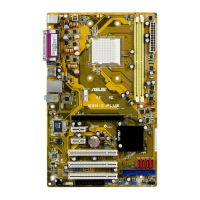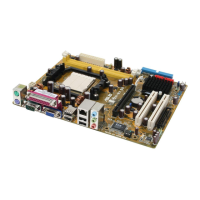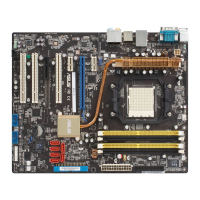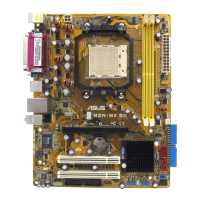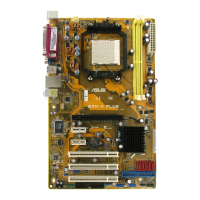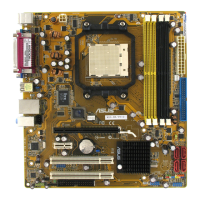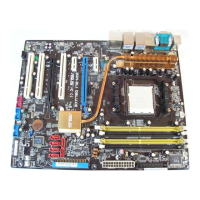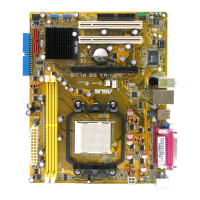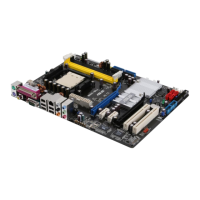Do you have a question about the Asus M2N-L and is the answer not in the manual?
Explains the structure and content of the user guide, outlining its main sections.
Lists resources for additional product and software updates from ASUS.
Details FCC compliance rules and potential interference with electronic devices.
Outlines compliance with Canadian regulations for radio noise emissions.
Provides crucial precautions for preventing electrical shock and equipment damage.
Lists guidelines for safe handling and installation of motherboard components.
Explains the meaning of text formatting like bold, italics, and key notations.
Lists supported processors, socket type, and HyperTransport bus speed.
Details memory slots, types, capacity, and size options.
Lists the total number and types of expansion slots available.
Covers IDE and SATA controller specifications, including RAID support.
Lists all items included in the motherboard retail and bulk packages.
Details key features like processor technology, memory, and PCI Express.
Describes unique ASUS features such as CrashFree BIOS 2 and Smart Fan.
Lists essential precautions for handling components and preventing static discharge.
Describes the motherboard layout, placement direction, and screw hole locations.
Guides on locating the CPU socket and installing the processor.
Explains DDR2 DIMM sockets, installation, and memory configuration options.
Details different expansion slots like PCI Express and PCI.
Explains the function and usage of jumpers like Clear RTC RAM.
Covers rear panel and internal connectors for peripherals and power.
Guides on the initial system power-on procedure, checks, and BIOS setup entry.
Explains methods for safely shutting down the system via OS or power switch.
Covers BIOS update utilities like AFUDOS and CrashFree BIOS 2.
Overview of accessing and using the BIOS setup utility, including navigation.
Displays basic system information within the BIOS setup interface.
Allows configuration of CPU, Chipset, and other advanced system settings.
Options for ACPI and APM power management features like suspend mode.
Configures system boot order, devices, and related settings.
Manages BIOS passwords, user access levels, and system security settings.
Details the contents of the motherboard support CD, including drivers and utilities.
Lists essential device drivers for hardware activation, such as Chipset and LAN.
Guides on enabling features like AMD Cool ‘n’ Quiet!™ Technology.
Explains different RAID levels like RAID 0, 1, 5, and JBOD.
Details on configuring RAID arrays using the NVIDIA utility, including volume creation.
Visual representation of the motherboard's architecture and component connections.
Explains the structure and content of the user guide, outlining its main sections.
Lists resources for additional product and software updates from ASUS.
Details FCC compliance rules and potential interference with electronic devices.
Outlines compliance with Canadian regulations for radio noise emissions.
Provides crucial precautions for preventing electrical shock and equipment damage.
Lists guidelines for safe handling and installation of motherboard components.
Explains the meaning of text formatting like bold, italics, and key notations.
Lists supported processors, socket type, and HyperTransport bus speed.
Details memory slots, types, capacity, and size options.
Lists the total number and types of expansion slots available.
Covers IDE and SATA controller specifications, including RAID support.
Lists all items included in the motherboard retail and bulk packages.
Details key features like processor technology, memory, and PCI Express.
Describes unique ASUS features such as CrashFree BIOS 2 and Smart Fan.
Lists essential precautions for handling components and preventing static discharge.
Describes the motherboard layout, placement direction, and screw hole locations.
Guides on locating the CPU socket and installing the processor.
Explains DDR2 DIMM sockets, installation, and memory configuration options.
Details different expansion slots like PCI Express and PCI.
Explains the function and usage of jumpers like Clear RTC RAM.
Covers rear panel and internal connectors for peripherals and power.
Guides on the initial system power-on procedure, checks, and BIOS setup entry.
Explains methods for safely shutting down the system via OS or power switch.
Covers BIOS update utilities like AFUDOS and CrashFree BIOS 2.
Overview of accessing and using the BIOS setup utility, including navigation.
Displays basic system information within the BIOS setup interface.
Allows configuration of CPU, Chipset, and other advanced system settings.
Options for ACPI and APM power management features like suspend mode.
Configures system boot order, devices, and related settings.
Manages BIOS passwords, user access levels, and system security settings.
Details the contents of the motherboard support CD, including drivers and utilities.
Lists essential device drivers for hardware activation, such as Chipset and LAN.
Guides on enabling features like AMD Cool ‘n’ Quiet!™ Technology.
Explains different RAID levels like RAID 0, 1, 5, and JBOD.
Details on configuring RAID arrays using the NVIDIA utility, including volume creation.
Visual representation of the motherboard's architecture and component connections.
| ECC | Yes |
|---|---|
| Number of memory slots | 4 |
| Maximum internal memory | 8 GB |
| Processor socket | Socket AM2 |
| Processor manufacturer | AMD |
| USB 2.0 connectors | 1 |
| Number of SATA connectors | 6 |
| Manageability features | ASWM 2.0 |
| Controller interface type | Serial ATA I/II |
| Controller 2nd interface type | UltraATA-100/133 |
| USB 2.0 ports quantity | 2 |
| Motherboard form factor | ATX |
| Maximum graphics card memory | 32 MB |
| Networking features | Dual Gigabit Ethernet |
| Storage temperature (T-T) | -20 - 70 °C |
| Operating temperature (T-T) | 10 - 35 °C |
| RAID levels | 0, 1, 0+1, JBOD |
